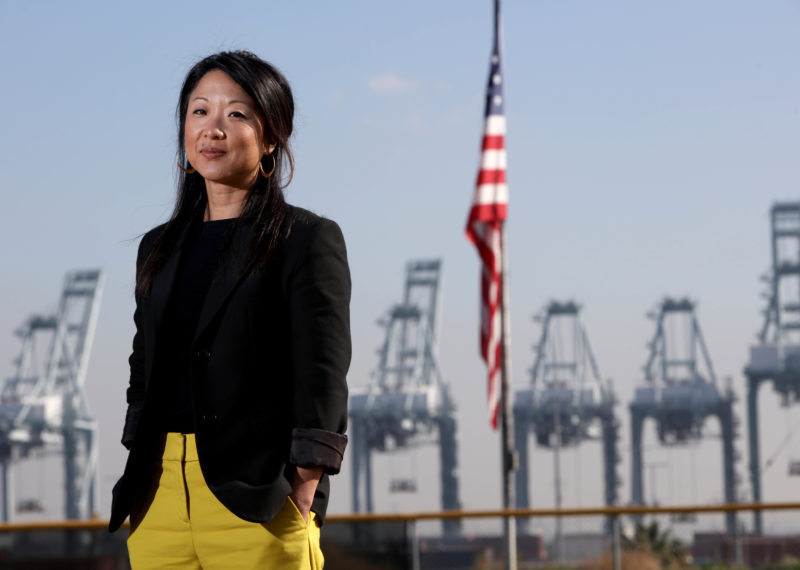The daughter of Chinese immigrants, Melissa Lin Perrella sees a direct line from her childhood in a small town in Central California in the 1980s to her work on the front lines of environmental justice.
“We looked different from most everyone else; my house smelled different because the food we ate was different; my parents had heavy, very noticeable accents,” she said. She was bullied. “It [affected] my confidence and what I thought was possible for myself, but it also made me the advocate that I am,” she said.
Today, Lin Perrella is the head of justice and equity for the NRDC (Natural Resource Defense Council), a role that was created last year. The move is part of a larger shift among environmental organizations toward recognizing the inequitable impacts of climate change and pollution..
Lin Perrella, 48, got her start with NRDC nearly 20 years ago in the organization’s Santa Monica office. She worked alongside communities near the ports of Los Angeles and Long Beach, areas with some of the worst air quality in the state, where residents suffer disproportionately from cancer and childhood asthma.
“That’s where I learned that in order for environmental policies to be responsive and durable, they have to be prioritized and really led by the communities that are most impacted by them,” she said.
In an interview with Nexus Media News, she discussed community power-building, “race-neutral” environmental policies and the connection between anti-Asian violence and environmental injustice. This conversation has been edited for clarity.
How has your understanding of environmental justice changed over the years?
In the beginning, I was very focused on outcomes. But what I think has deepened over the years is my understanding of how to do that work—the need to honor local community leadership and intentionally take care not to supplant it. Even a well-intended organization can disrupt local power building if it does not intentionally look for ways to share power. I’ve learned that environmental justice means reducing pollution in communities of color and low-income communities, and building community power as part of that work.
How does that inform your new role at the NRDC?
If we’re working alongside communities to close down a polluting facility, NRDC shouldn’t just stop there. We should also be working alongside communities to transition workers at that facility [to green jobs]. If we’re going to propose new green spaces—new parks and trails—we should be working alongside housing advocates to ensure that the new park doesn’t result in gentrification or the loss of historic neighborhoods.
Tell me about your work on clear air in Southern California.
The operations at the ports of LA and Long Beach produce more smog-forming pollution than all 6 million cars in the region. When I was an NRDC clean-air attorney, we recognized that if we wanted to make any dent in Southern California’s air pollution problem, we had to tackle the air pollution coming from port operations. That’s all of the ships, trains, trucks and equipment. Something like 40 percent of all the goods that come into the US by water come in through the ports of LA and Long Beach.
The movement of all of those goods has created diesel death zones in Southern California. These are communities with higher rates of cancer, premature death and childhood asthma. NRDC has worked alongside community partners for about 20 years now, developing innovative, first-of-their-kind clean air policies with the port. [We’ve sued] the port when we felt like we needed to and [supported] the port when we thought they adopted a good policy.
You’ve said that being bullied as a child for being Asian American is part of what brought you to advocacy work. Do you see a connection between anti-Asian violence and environmental injustice?
All forms of violence, whether it’s a punch to your gut or pollution that burns your lungs, is targeted at those who are perceived as unable to fight back. Attackers choose who they attack.
I’m vulnerable because of my race, my gender, my size, and similarly, polluters don’t site their facilities randomly. They go for communities that are perceived as lacking the power to resist.
That’s why I think it’s so important for the environmental movement to support community power-building so that these perceptions change.
The environmental movement should not be viewing these communities as mere clients or signatories to a petition. We have to support [community] efforts to organize and lead the change they want to see so that they can [regain] power… so that those perceptions change, and, in fact, [communities] are able to fight back, whether it’s against hate crimes or environmental pollution.
The Biden administration has pledged to deliver 40 percent of federal climate-related investments to “disadvantaged communities,” and released a screening tool to determine which communities to include. The tool has been criticized because it doesn’t include race. Can a “race-neutral” environmental justice strategy succeed?
You need a comprehensive suite of policies and tools that consider race in order to correct long-standing environmental racism, and to see whether the policies enacted actually reduced racial disparities in environmental protection and health outcomes.
Some of these policies include restrictions on [situating] new environmental hazards in places that already [experience] high and disproportionate amounts of pollution. They should also include actions to reduce existing pollution burdens on low-income communities and communities of color.
It’s not a mystery what needs to be done. Environmental justice advocates’ vision and policy priorities can be found in initiatives like the federal Environmental Justice for All Act, a bill that environmental justice leaders have been instrumental in crafting. From where I sit in NRDC, I can use the organization’s platform to lend its support to these voices and efforts.
This article was made possible by a grant from the Open Society Foundations. Nexus Media News is an editorially independent, nonprofit news service covering climate change. Follow us @NexusMediaNews.


